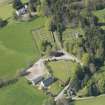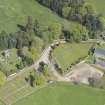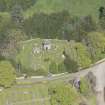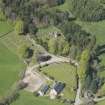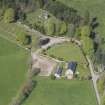Cluny, Old Churchyard
Burial Ground (18th Century)
Site Name Cluny, Old Churchyard
Classification Burial Ground (18th Century)
Alternative Name(s) Old Churchyard Of Cluny; Linton Burial-enclosure; Old Cluny Churchyard
Canmore ID 135634
Site Number NJ61SE 5
NGR NJ 68472 12563
NGR Description Centred on NJ 68472 12563
Datum OSGB36 - NGR
Permalink http://canmore.org.uk/site/135634
- Council Aberdeenshire
- Parish Cluny
- Former Region Grampian
- Former District Gordon
- Former County Aberdeenshire
There are other treasures in the kirkyard, including the Linton burial enclosure, elegant but simple, neo-Greek ashlar, possibly by Archibald Simpson, and an unusual terracotta early Italian Renaissance monument to James Reid and his wife Marie Claudine Nardin, probably 1897. There are also four well-preserved mortsafes in front of the Fraser mausoleum.
Taken from "Aberdeenshire: Donside and Strathbogie - An Illustrated Architectural Guide", by Ian Shepherd, 2006. Published by the Rutland Press http://www.rias.org.uk
NJ61SE 5.00 68472 12563
NJ61SE 5.01 NJ 68481 12571 Fraser Mausoleum
NJ61SE 5.02 NJ 6847 1255 St Machar's Church (Old Church of Cluny)
For adjacent and present Cluny Cemetery, see NJ61SE 28.
Grave Yard [NAT]
OS 1:10,000 map, 1973.
Apart from the Fraser Mausoleum (NJ61SE 5.01), the kirkyard is noteworthy for the following: Linton burial-enclosure: an elegant but simple monument (possibly by Archibald Simpson) in neo-Greek ashlar, monument to James Reid and his wife Marie Claudine Nardin, probably of 1897, an unusual terracotta work in early Italian Renaissance style, and four well-preserved mortsafes (in front of the Fraser mausoleum).
I Shepherd 1994.
Old Cluny Churchyard. Site of St Machar's church; the first kirk belonged to the cathedral of Aberdeen and is first mentioned in the taxation of 1225. About 1732 it was described as 'cross church' with two aisles; it was ruinous about 1789 and was demolished.
The old churchyard contains four mortsafes and a few old stones; unusual terracotta Early Italian renaissance monument to James Reid and his wife, c. 1897. It also contains the Fraser Mausoleum; neo-classical, circular ashlar granite with moulded base on a low square podium, architraved doorpiece with wrought-iron grille and a fine coat-of-arms over it; the dome has an oculus.
(GRC/AAS photography listed).
NMRS, MS/712/57.
Cluny burial-ground occupies a SSE-facing slope at the end of a ridge overlooking the boggy valley of the Ton Burn. The ground falls away on all sides except the N, and it is steepest on the S. Nothing can be seen of the medieval church, and the burial-ground is dominated by the tall, domed mausoleum of Eliza Fraser (dated 1808), which stands upon a terrace in the N half of the enclosure.
To the NW of this monument lies the burial-enclosure of the Frasers of Linton. This is of early 19th-century date, although the single stone it contains is dated 1996. To the SW of the mausoleum there is a platform measuring 6m from N to S by 4m transversely and 0.5m in height, upon which lie four mortsafes. These are of a uniform pattern, comprising a coffin-shaped granite slab, 2.15m in length by 0.74m in width and 0.15m in thickness, fastened to a wrought-iron, riveted cage, 0.28m in height.
The burial-ground contains numerous simple, round-headed, granite headstones, similar in form to those at Monymusk (NJ61NE 4) and Kemnay (NJ71NW 4). The earliest noted bear the dates 1800 and 1806.
It was not possible to examine any recumbent monuments due to a covering of snow on the date of visit.
Visited by RCAHMS (IF, AW), 20 November 1996.
Publication Account (1986)
The old kirkyard rests on a little knoll opposite the present palish kirk of 1789. Its most striking feature is the splendid neo-classical ma usoleum of 1808 to Miss Elyza Fraser of Castle Fraser (no. 21). Designed by her friend, the aesthete James Byers of Tonley (to whom she left her carriage and best pair of horses), it is of granite ashlar, circular in plan, sitting on a low plain square podium and rising to a tall, domed roof. The doorway is narrow and high, with an intricate wrought-iron gIille, surmounted by a fine triangular heraldic panel. Around the frieze in elegant capitals is the inscription ELIZABETH FRASER OF CASTLE FRASER MDCCCVIII. It cost £353 and is the finest classical tomb in the north-east. In front of the mausoleum stand four mortsafes, consisting of iron cages which would have enclosed the coffin in the grave, topped by massive slabs of granite which would have been extremely diffIcult to shift clandestinely. Such weighty mortsafes required block and tackle to manoeuvre them into the grave; a set is preserved in Inverurie Museum.
Information from ‘Exploring Scotland’s Heritage: Grampian’, (1986).
Publication Account (1996)
The old kirkyard rests on a little knoll opposite the present parish kirk of 1789, within the policies of the splendidly baronial Cluny Castle. Its most striking feature is the splendid neo-classical mausoleum of 1808 to Miss Elyza Fraser of Castle Fraser (no. 21). Designed by her friend, the aesthete James Byers of Tonley (to whom she left her carriage and best pair of horses), it is of granite ashlar, circular in plan, sitting on a low plain square podium and rising to a tall, domed roof. The doorway is narrow and high, with an intricate wrought-iron grille, surmounted by a fine triangular heraldic panel. Around the frieze in elegant capitals is the inscription ELIZABETH FRASER OF CASTLE FRASER MDCCCVIII. It cost £353 and is the finest classical tomb in the north-east. Byers planned to be interred in a similar tomb but subsequently changed his will. In front of the mausoleum stand four mortsafes, consisting of iron cages which would have enclosed the coffin in the grave, topped by massive slabs of granite which would have been extremely difficult to shift clandestinely. Such weighty mortsafes required block and tackle to manoeuvre them into the grave; a set is preserved in Inverurie Museum.
Information from ‘Exploring Scotland’s Heritage: Aberdeen and North-East Scotland’, (1996).

























